MIT Lesson 23A Kanji: 第23A課の漢字
 Warning! There is Japanese text on this page. If it looks like this:$BI4@i instead of this: "
Warning! There is Japanese text on this page. If it looks like this:$BI4@i instead of this: " ", then read this.
", then read this.
 Each large, brush-stroke image below which shows up as a hypertext link (e.g. has a colored box around it) is a link to an animation of the character being painted with a brush.
Each large, brush-stroke image below which shows up as a hypertext link (e.g. has a colored box around it) is a link to an animation of the character being painted with a brush.
In the following definitions, on (Chinese-based) readings
are represented by katakana; kun (native Japanese-based)
readings are represented by hiragana. This is a common dictionary
convention, and does not have any bearing on meaning.
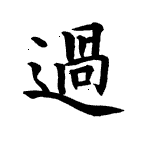
-
Printed form:
- 過
-
Readings:
- カク
- す(ぎる)
- す(ごす)
-
Meaning:
- pass; exceed
-
Usage Examples:
- 過ぎる
- 食べ過ぎる
- 五分過ぎ
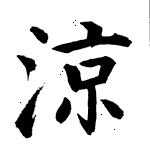
-
Printed form:
- 涼
-
Readings:
- リョウ
- すず(しい)
-
Meaning:
- cool
-
Usage Examples:
- 涼しい
- 涼風 (りょうふう) cool wind
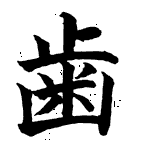
-
Printed form:
- 歯
-
Readings:
- シ
- は
-
Meaning:
- tooth, teeth
-
Usage Examples:
- 歯が痛い
- 歯医者
- 歯科 (しか) dental dept.
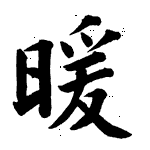
-
Printed form:
- 暖
-
Readings:
- ダン
- あたたか(い)
-
Meaning:
- warm
-
Usage Examples:
- 暖かい
- 暖かい日
- 暖房 (だんぼう) heater
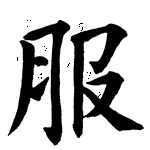
-
Printed form:
- 服
-
Readings:
- フク
-
Meaning:
- clothes
-
Usage Examples:
- 服を着る
- 服を脱ぐ (ぬぐ)
- 洋服
- 和服
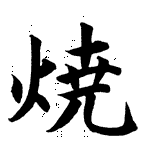
-
Printed form:
- 焼
-
Readings:
- ショウ
- や(く)
- や(ける)
- やき
-
Meaning:
- burn
-
Usage Examples:
- ケーキを焼く
- 日焼けする
- 焼そば fried noodle
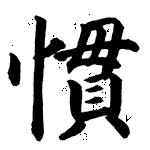
-
Printed form:
- 慣
-
Readings:
- カン
- な(れる)
-
Meaning:
- get used to; become experienced to
-
Usage Examples:
- 習慣 (しゅうかん) custom
- 言葉に慣れる
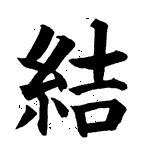
-
Printed form:
- 結
-
Readings:
- ケツ
- むす(ぶ)
-
Meaning:
- tie; conclude
-
Usage Examples:
- 結婚する
- 結果 (けっか)

-
Printed form:
- 婚
-
Readings:
- コン
-
Meaning:
- marry
-
Usage Examples:
- 結婚
- 婚約する engage to be married
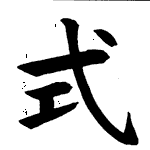
-
Printed form:
- 式
-
Readings:
- シキ
-
Meaning:
- ceremony
-
Usage Examples:
- 結婚式
- 入学式 (にゅうがくしき)
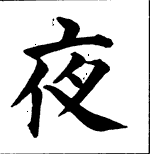
-
Printed form:
- 夜
-
Readings:
- ヤ
- よる、よ
-
Meaning:
- night
-
Usage Examples:
- 夜になる
- 今夜 (こんや)
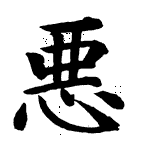
-
Printed form:
- 悪
-
Readings:
- アク
- わる(い)
-
Meaning:
- bad
-
Usage Examples:
- 悪い人
- 悪い成績 (せいせき) a bad grade
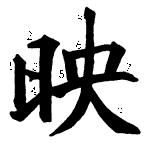
-
Printed form:
- 映
-
Readings:
- エイ
-
Meaning:
- reflect; project
-
Usage Examples:
- 映画を見る
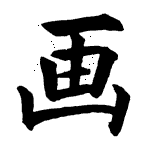
-
Printed form:
- 画
-
Readings:
- ガ
- か(く)
-
Meaning:
- draw; picture
-
Usage Examples:
- 映画
- 絵画 (かいが) painting
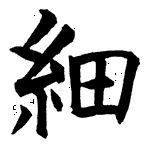
-
Printed form:
- 細
-
Readings:
- サイ
- ほそ(い)
- こまか(い)
-
Meaning:
- slender; minute
-
Usage Examples:
- 細いウエスト
- 細かい (こまかい)
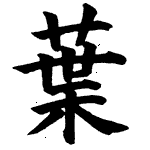
-
Printed form:
- 葉
-
Readings:
- は、ば
-
Meaning:
- leaf
-
Usage Examples:
- 葉の色
- 言葉
 Warning! There is Japanese text on this page. If it looks like this:$BI4@i instead of this: "
Warning! There is Japanese text on this page. If it looks like this:$BI4@i instead of this: " ", then read this.
", then read this. Warning! There is Japanese text on this page. If it looks like this:$BI4@i instead of this: "
Warning! There is Japanese text on this page. If it looks like this:$BI4@i instead of this: " ", then read this.
", then read this. Each large, brush-stroke image below which shows up as a hypertext link (e.g. has a colored box around it) is a link to an animation of the character being painted with a brush.
Each large, brush-stroke image below which shows up as a hypertext link (e.g. has a colored box around it) is a link to an animation of the character being painted with a brush.














